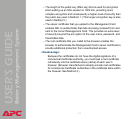
®
USER’S GUIDE
Battery Management System
117
Secure Sockets Layer (SSL)
For secure Web communication, you enable Secure Sockets Layer (SSL)
by selecting HTTPS (SSL) as the protocol mode to use for access to the
Web interface of the Battery Management System. Hypertext Transfer
Protocol over Secure Sockets Layer (HTTPS) is a Web protocol that
encrypts and decrypts page requests from the user and pages that are
returned by the Web server to the user. Originally developed by Netscape, it
has become an internet standard supported by most Web browsers.
The Battery Management System supports SSL version 3.0. Most browsers
let you select the version of SSL to enable.
When SSL is enabled, your browser displays the lock icon,
usually at the bottom of the screen.
SSL uses a digital certificate to enable the browser to authenticate the
server (in this case, the Battery Management System). The browser verifies
the following:
• The format of the server certificate is correct.
• The server certificate’s expiration date and time has not passed.
• The DNS name or IP address specified when a user logs on matches
the common name in the server certificate.
• The server certificate is signed by a trusted certifying authority.
Each major browser manufacturer distributes CA root certificates of the
commercial Certificate Authorities in the certificate store (cache) of its
browser so that it can compare the signature on the server certificate to the
signature on a CA root certificate.


















